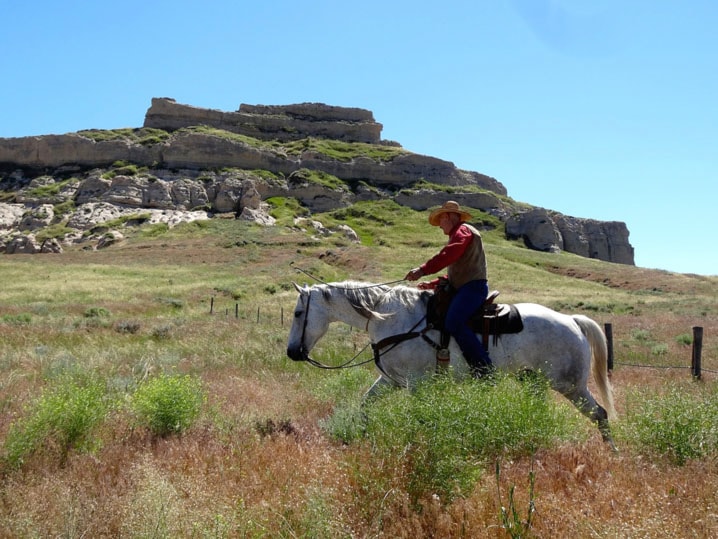Was the Wild West really wild? Watching John Wayne westerns as a child, I believed early North American settlers faced constant peril from gunslingers, Cheyenne ambushes, and stagecoach robberies.
The West was not a California sound stage or even the most westerly of states. It included many places in the Midwest that have much duller reputations today. I set off to Nebraska, home of the Platte River Road and Buffalo Bill’s Wild West show, to uncover the truth.
During the mid 1800s, approximately 400,000 American settlers moved west from Missouri on the Platte River Road to Oregon, Utah and California. For the emigrants crossing Nebraska, western life was dangerous, but not from violence. Although some people died in fights with Sioux or Cheyenne warriors, many more died from cholera, accidental gun discharges or trying to cross a river with eight oxen, a wagon and no swimming skills.
As I wandered among the exhibits at Chimney Rock Historic Site, it seemed settlers were more likely to describe the crossing as difficult, but tedious, with each day bringing more walking, insects and hard tack biscuits.
The Pony Express is perhaps one of the most enduring symbols of the Wild West. Nebraska had more miles of Pony Express trail than any other state and celebrates the partnership of horse and rider at a monument in Sidney, Neb.
I felt like I was being told there was no Easter Bunny again, when local historian and city manager, Gary Person explained that the Pony Express, an enduring symbol of the Wild West, was only in existence for 18 months and was hailed by some as merely a publicity stunt.
Three gentlemen hoping to secure a government contract for mail delivery started the Pony Express. Riders carrying mail raced from Missouri to California on horses, changing horses every 16 km (10 miles). Riders were not grizzled cowboys, but 12- to 13-year-old boys, light as modern-day jockeys, asked to sign an oath swearing they would abstain from alcohol, swearing and fighting. Orphans were preferred; perhaps because riders were not issued guns, instead, they were instructed to outrun interlopers!
Train robberies really did happen in the Wild West, but not as often as I thought.
Union Pacific Railways was first robbed in 1877 at Big Springs, Neb. When bandits discovered there was more money on trains than stagecoaches, they started attacking people on rails. Train companies got tired of losing money and hired the newly-formed Pinkerton security company to be badder than the bad guys. Within in a decade, train robberies became much less common.
But there was one place were the West was truly wild. Sidney, Neb., became a major staging area from 1875 to 1891 for people seeking gold in the South Dakota’s Black Hills. There were 80 legal saloons on Front Street, brothels and an all-night theatre. There were lynching and murders — 56 during this time period — earning the town the moniker “Wicked Sidney.”
Three local newspapers struggled to keep up with the reports of the debauchery, popular with readers in eastern states.
Sidney had one sheriff for the town and a county area that was larger than some eastern states. Lawlessness prevailed and the Union Pacific Railway, tired of the violence, told the town they had to restore order or they would no longer stop there. A notice was posted telling all criminals to get out of town or risk hanging.
The threat was so successful that nearby Dodge City, Kan., adopted it, creating the line made famous on the television show Gunsmoke. “Get out of Dodge was based on policy started in Sidney, but get out of Sidney doesn’t sound as good,” laughs historian and Sidney city manager Gary Person.
Today, Sidney is home to Cabela’s, a large hunting and outdoor recreation retailer, the new face of the Wild West.
I could still hear whispers of the Old West in Nebraska, but realized the violence of frontier life had been overstated on the westerns I loved as child. However, the wild was still there. The land that spawned the legends of gunfights, circling of wagons and train robberies was waiting to be explored. I put on my boots and headed out to find a prairie dog.
If you go
• Visit the home of the most famous Pony Express rider at Buffalo Bill Ranch State Historical Park near North Platte (http://1.usa.gov/1qyesyf).
• Stop by the Pony Express monument in Sidney, Neb., honouring all the states that the riders journeyed to. Steps away, visit Cabela’s original retail store where guns are checked at the door.
• Learn more about the reality of frontier life at Chimney Rock Historical Site in Bayard, Neb. (www.nebraskahistory.org/sites/rock)
Carol Patterson helps inspire everyday explorers within organizations. When she isn’t travelling for work, Carol is travelling for fun. More of her adventures can be found at www.carolpatterson.ca.
